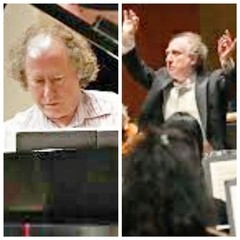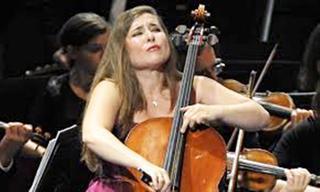|
Back
Cyclone Bomb? It’s The Thawed That Counts New York
David Geffen Hall, Lincoln Center
01/04/2018 - & January 5, 6, 9, 2018
Wolfgang Amadeus Mozart: Piano Concerto No. 17 in G Major, K. 453
Peter Ilyich Tchaikovsky: Variations on a Rococo Theme for Cello and Orchestra, Opus 33
Joseph Haydn: Symphony No. 98 in B Flat Major, Hob.I:98
Alisa Weilerstein (Cello)
New York Philharmonic Orchestra, Jeffrey Kahane (Conductor and Piano)

J. Kahane (Pianist/Conductor) (© GettyImages.com/Thegilmore.com)
Villon’s question: “Mais où sont les neiges?” New Yorker answer: “Downtown!”
François Villon (1431-1463?) (Revised)
David Geffen Hall was not filled last night, but for a few hundred intrepid snow-trippers (and this writer tripped several times), the chance to hear Alicia Weilerstein was the magnet to overcome all seasons. Not that the great cellist was actually the star of the concert. Jeffrey Kahane, a favorite artist in New York, was keyboard soloist in two works, conducting the trio of light-hearted pieces.
The emotional link was simply that each of the pieces were light, sprightly, the three composers obviously enjoying their work. The historical link is that they all had a link with Wolfgang Amadeus Mozart.
Mozart himself was represented in the first half with his 17th Piano Concerto, a work whose joys speak for themselves, a piece of unaffected inspiration that demands respect from its interpreters. Jeffrey Kahane played his two roles here not quite with flamboyance but hardly with restraint. He jumped up, directed the Phil, plunked himself down (after a split-second adjustment to his jacket), produced dazzling runs on the piano, leaped up, lifted his jacket, sat, played Mozart’s cadenza, suddenly changed the atmosphere to Andante and repeated, for a good half-hour.
It was a fairly impressive performance, and Mr. Kahane is one smooth operator on piano and with baton. This was certainly an amiable Mozart, filled with roulades, brilliant trills and all the amenities that makes Mozart as likeable as Mr. Kahane himself. True, the Phil was not at its sharpest here. Possibly this was because of Mr. Kahane’s less than perfect dual role, or the lack of a rehearsal due to the weather.
Still, this was basically a sunny warm performance, an antidote to the blizzard dangers outside Lincoln Center. Missing, though, was Mozart of inner secrets, Mozart the dramatist, Mozart with those nuances of darkness, those Rembrandt-like shadows which separated Mozart from his numerous contemporaries.

A.Weilerstein (© classicalvoiceamerica.com)
After the intermission, Alicia Weilerstein needed no excuse to give us a her usual enchanting performance of Tchaikovsky in his best mood, his Rococo Variations. Ms. Weilerstein, in a gown which could have from The Phantom Thread, has played this innumerable times (I believe it was her introductory work), yet she always provides–besides unerring finger-work, phrasing and lyricism–the sense of the ballet which pervades the piece.
Not that even the most physical dancer could perform to her fiery performance. The Variations might have been modeled on Mozart, but it was Russian all the way through. And while that opening could be considered elegant, the stuff of ersatz 18th Century movie-regality, Ms. Weilerstein quickly relinquished Mozart and gave it the Firebird treatment.
In this case, Mr. Kahane’s penchant for flamboyance was in step with Ms. Weilerstein. He had a larger force than his usual Los Angeles Chamber Symphony, and wisely allowed the cellist to soar unfettered.
To those who braved the weather to hear “the expected”, Haydn’s Symphony No. 98 was totally unexpected. It is rarely played (the last New York Philharmonic performance was 17 years ago), but has such a wealth of secrets that it deserves to be heard as much as possible.
One secret is Haydn’s tribute to Mozart, who had died a few weeks before the creation. Other composers might have slipped in a Mozart theme or two. Haydn was more subtle. That second movement has moments which act as an ostinato to Mozart’s contrapuntal tricks in the 41st Symphony second movement. Haydn’s idea of a Requiem was not to mourn but to celebrate. And Mr. Kahane, with his second keyboard of the night, a Haydnesque fortepiano, paid enough attention for a truly moving celebration.
For the rest, Mr. Kahane paid respect to Haydn’s little jokes, the most notable being the pianoforte mini-cadenza right at the end. Mr. Kahane, in this case balancing conducting, continuo-playing and turning the score (which one doubts he needed) played the 11-odd measures with almost enough delight to make the ice-treacherous steps of Lincoln Center a minor hazard.
CODA 1: James Keller’s splendid program notes have one error. He states that Mozart’s pet starling was “taught” the last-movement theme of the 17th Concerto. As Lyanda Lynn Haupt explains in her charming, erudite, revelatory book Mozart’s Starling, the composer was startled to hear a caged starling from a Vienna bird-seller, actually whistling the tune which Mozart had recently composed. Enamored by the coincidence, Mozart bought the bird, brought him to the Mozart’s crowded apartment and may well have composed music for Magic Flute and other works from the sounds. So was the starling’s original tune simply a coincidence? Ms. Haupt deduces a complex but reasonable case that Vogel Bird (Star Bird) was more clever than the composer thought.
CODA 2: Our monster snowfall alas prevented this writer from driving to Redding, Connecticut for another rare Mozart sound this weekend. A concert including Mozart and other composers writing for the glass armonica–a “machine” engineered by Benjamin Franklin–will be held at the Redding Congregational Church at 3pm on Sunday. The internationally-known glass armonicist Dennis James will perform in a concert sponsored by the Mark Twain Library. Which incidentally was given to the town by a devotee of Ben Franklin, Mr. Twain himself. Seats are free but limited.
Googling (which could be an utterance by Mozart’s delightful bird) will give more information.
Harry Rolnick
|